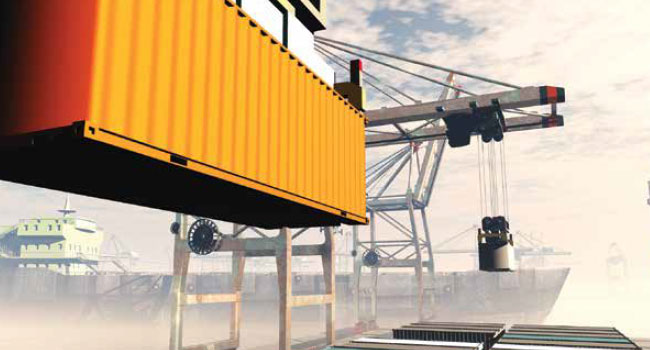
Communication Is Critical
Improving public facilities ensures the economic impact to the nation
- By Jim Hoffpauir
- Jul 01, 2016
Ports serve a vital role in the health of a national economy and a
critical role in many regions. As an example, according to many in
Texas, “Houston is the town that built the port that built the city.”
According to its website, The Port of Houston is the nation’s
largest port for foreign waterborne tonnage. The port is an economic
engine for the Houston region, the state of Texas and the nation. It supports
the creation of more than 1.175 million statewide jobs and more than 2.1
million jobs nationwide, and the generation of economic activit y totaling more
than $265 billion in Texas. That is roughly 16 percent of Texas’ total gross domestic
product. As well, it generated more than $617 billion in economic impact
across the nation.
The Port of Houston exemplifies how vital ports are to the local, state and
national economy. Maintaining and improving the public facilities ensures the economic
impact of ports. Correspondingly, keeping ports secure so that business can
flow freely is also an essential responsibility. Many ports synthesize the activities
of Health, Safety, Security & Emergency Management as a critical priority alongside
the operational flow of the business. If an event did occur, ports count on the
ability to respond, recover and then maintain the continuity of port operations.
One of the keys to making this possible is critical communications technology.
Critical Communications can take the form of audio and data solutions that
can be applied in any environment that requires the protection of human life,
and property as well as the management of critical operational tasks. Many
of these solutions depend on IP-based Intercom and public address solutions
to deliver clear, intelligible audio in highly noisy environments using standard
power over Ethernet connections. These audio solutions often require the seamless
integration into other commonly used technologies so a virtual presence
can be achieved.
Critical communications technology vendor Vingtor-Stentofon has supported
many port security programs. They partner with integrators that have experience
and expertise in port operations. Texas Technical Services Inc. is one example.
Paul Rux, director of the South Central Region for Vingtor-Stentofon shared
his experience in partnering with Texas Technical on a number of port applications
around their critical communication needs. Here is what he found to be the
key pillars of a critical communications scorecard for ports:
Intelligibility is a priority and it cannot be validated by a brochure. One of
the largest ports purchased a communications solution from a perceived leader in the communications market. It was eventually displaced because of its inability
to produce sound that could be heard and understood. “Intelligibility” reorients
your priorities by establishing a benchmark that communication must be able to
be heard, to be scaled, and to be understood. From a single person within range of
an intercom station to the ability to broadcast critical instructions during an emergency
across a substantial distance and in competition with noise from operations,
environment or the chaos of an emergency, no technology company is successful
without having audio expertise as a cornerstone of their strategy.
Interoperability is critical because communication systems must integrate seamlessly
with other mission critical port systems such as access control, networked
intercom systems, intrusion detection, remote monitoring and video surveillance.
Ports recognize that its ecosystem depends on security having a voice as well as
eyes, ears and feet on the ground. To test this, you must assess your overall infrastructure
and your future path and benchmark other implementations in your
sector. An integrator can help with this.
The “Ilities”. The port is subject to standards and regulations. How it addresses
these can be from a compliance perspective. But better yet, are the ports that drive
maintainability, sustainability, reliability, and availability as competitive differentiators.
An example that can be accessed from the Port of Houston’s website: On
March 27, 2008, the Port Security & Emergency Operations Department Security
Management System (SMS) was certified to ISO 28000:2007, making it the first
port authority in the world to receive this international security designation. Since
the port is composed of people performing roles in a process using technology,
the ISO standard provided a response to the market demand for enhanced supply
chain security.
From a specification perspective, the following elements are often called out in
requests of proposals from ports.
- Deter, detect, document, delay and respond.
- Access entry/exit audit trail.
- Mustering points.
- Emergency notifications.
- Command and control.
- Crisis management.
- Constant monitoring via CCTV, access control and alarms.
- Access rights are highly controlled, managed, recorded and monitored.
As is evident here, many ports are looking for advanced integrations with other
applications within their environment. A critical focus in on the integration with
their access control systems.
According to Dan Rothrock, Vice President of Strategic Alliances for Vingtor-
Stentofon, this demand for interoperability cannot be addressed by simply announcing
integration.
“The true test for integrated solutions that stand the test of time is the ability to
identify the leaders in the market, collaborate with them to ensure full functionality
and performance, and then develop core processes for maintaining and sustaining
that integration over time,” Rothrock said. “This is not trivial but can be tested
by organizations through the due diligence process.”
The lessons from addressing port demands for predictable, reliable and sustainable
communications are transferrable to other industries. The business of the port
involves many people, processes and technology elements. Success of its core business
depends on how optimized these elements become. What
ports have learned applies to every business. Communication is
critical and cannot be compromised. Intelligibility, Interoperability
and the “Ilities” must be the key foundation for establishing
the measures of performance before and after the deployment.
This article originally appeared in the July 2016 issue of Security Today.